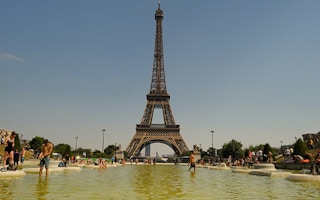Nothing is certain until it happens, but the World Meteorological Organisation (WMO) is confident enough say the gathering pace of climate change means that 2015 is likely to prove the warmest year on record.
Global average surface temperature, it says, is likely to be the warmest yet, and to reach “the symbolic and significant milestone of 1°C above the pre-industrial era” − halfway to the 2°C threshold that governments have agreed as the maximum warming tolerable if the Earth is to avert dangerously unpredictable climate change.
The WMO says the combined causes of this historically unprecedented heat are both natural and human-induced: astrong El Niño − the periodic climate phenomenon in the Pacific − and anthropogenic warming resulting from the rising emissions of greenhouse gases, largely through the burning of fossil fuels, agriculture and deforestation.
Extreme weather events
Not only does this year look likely to be a record-breaker, but a five-year analysis by the WMO shows the years 2011-2015 to have been the warmest five-year period on record, with many extreme weather events – especially heatwaves – influenced by climate change.
“The state of the global climate in 2015 will make history for a number of reasons,” says Michel Jarraud, the WMO secretary-general. “Levels of greenhouse gases in the atmosphere reached new highs, and in the northern hemisphere spring 2015 the three-month global average concentration of CO2 crossed the 400 parts per million barrier for the first time.
“2015 is likely to be the hottest year on record, with ocean surface temperatures at the highest level since measurements began. It is probable that the 1°C threshold will be crossed. This is all bad news for the planet.
“Greenhouse gas emissions, which are causing climate change, can be controlled. We have the knowledge and the tools to act. We have a choice. Future generations will not.”
“Added to that, we are witnessing a powerful El Niño event, which is still gaining in strength. This is influencing weather patterns in many parts of the world, and fuelled an exceptionally warm October. The overall warming impact of this El Niño is expected to continue into 2016.”
The WMO issued its provisional statement on the status of the climate in 2015, and the additional five-year analysis for 2011-2015, to inform negotiations at the UN climate change conference due to start in Paris on 30 November.
The negotiators’ main task there will be to work out an agreement that will take the world closer to reaching the 2°C target. There is no prospect that they will reach the target itself, but they may make significant progress towards it.
Although the WMO’s announcement will remind delegates of the urgency of reaching an agreement, they will still need to reckon with the insistence of some countries that development must take priority over a low-carbon economy.
India, the world’s third largest emitter of greenhouse gases, plans to open one large new coal mine a month until 2020, and expects to triple its emissions by 2030.
Investment in renewables
Its former environment minister, Jairam Ramesh, told the BBC: “The people who have put carbon dioxide in the atmosphere over the last hundred years must take the greater responsibility for cutting the emissions.
“We are making a huge investment in renewables … but even with the most aggressive solar, aggressive nuclear, aggressive hydro, we’ll still need to double our coal consumption over the next 15 years.”
Many experts argue that 2°C is a politically-chosen threshold, with little scientific justification, and some influential voices say the target should be as low as 1.5°C. These include some of the states most threatened by climate change.
The WMO’s preliminary estimate, based on data from January to October, shows that the global average surface temperature for 2015 so far is around 0.73 °C above the 1961-1990 average of 14°C, and approximately 1°C above the pre-industrial 1880-1899 period. The global average sea-surface temperature, which set a record last year, is likely to equal or surpass that record in 2015.
By the end of September this year, 2011-15 was the world’s warmest five-year period on record, at about 0.57°C above the 1961-90 average. It was the warmest five years recorded for Asia, Europe, South America and Oceania, and for North America.










